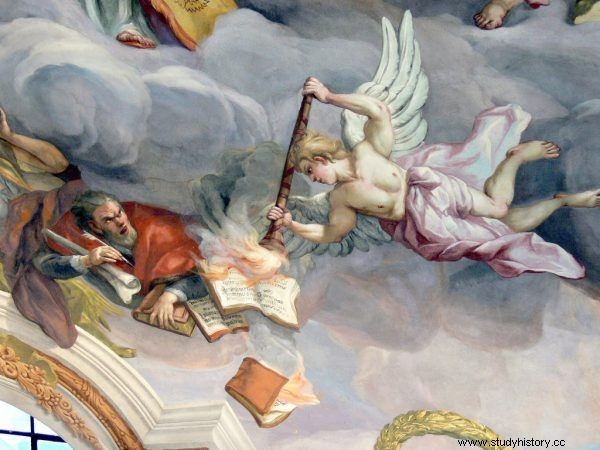Everyone has heard of the forbidden books index. But how did church censorship work in practice? How were official prohibitions implemented to protect innocent souls from sinful reading? The answers to these questions are not obvious even to historians. Thanks to Izabela Wiencek's research, we at least know what was done with the unreliable books in the monastic libraries.
Church restrictions on access to publications placed "on the index" primarily affected the clergy themselves. During the period of compulsory reformation, censorship was applied to, inter alia, collections of monastic libraries.
In the Library of the University of Warsaw a collection of 63 old prints from the library of the Jesuit monastery in Łomża has been preserved, which were subjected to "cleansing" by one monk, Andrzej Obrebski. Thanks to them, we got a unique opportunity to look at the work of the church censor.
Numerous and various censorship marks left on the books by the Jesuit are an unprecedented testimony to the implementation of the then church and religious recommendations regarding forbidden books - writes Izabela Wiencek in "Studia Źródłoznawcze".

Allegory of Faith:An Angel Burns Martin Luther's Heretical Writings. Fresco by Johann Michael Rottmayr in the Church of St. Charles Borromeo in Vienna (image:public domain).
Thread, scissors and glue
The first step was selection. Books that were banned in their entirety or written by condemned authors were appropriately marked and placed in a separate room or wardrobe. Its contents could only be accessed by persons with special permission.
The prints that could be made available after they were properly "cleaned" also had to be captured. This meant procedures such as deleting and pasting harmful phrases as well as stitching and cutting out even multi-page blocks of text. Special indexes, pointing to specific parts of the books that needed to be removed, were helpful in this process.
All kinds of preface and commentaries to non-forbidden works written by heretical authors had to be checked and possibly censored. Even all kinds of handwritten annotations in the margins were cleaned up, as long as they contained inappropriate thoughts.

The material is based on a scientific article published in the periodical "Studia Źródłoznawcze".
The censor will not let the book pass
The control was very meticulous. As Izabela Więcek, Obrebski writes:
(...) blurred (or edited) names of illegal publishers, commentators, printers and other contributors to the work appearing on the title pages and inside the book. He similarly eliminated dissident print sites listed in the publishing address.
The censor also added his own comments. In one of the editions of "The History" of Polybius, the monk removed the name of a Protestant theologian, one of the two translators of the work. However, he did not stop there and added a biographical note on the Greek historian, along with information about the second Catholic author of the translation.
Sometimes censorship was less restrictive. In a treatise by the Protestant theologian Melanchthon, On the soul, the author's name was stuck everywhere and the introduction was removed, but the rest of the book survived. Perhaps Obrebski felt sorry for the comments made in the margins by the previous owner.

Martin Luther was not at all an advocate of freedom of speech. Apart from the Catholic censorship, of course, there was also the Protestant censorship (fig. Public domain).
On the title page of one of the censored books, the Jesuit added the words from the biblical Book of Syracides: do not say:I have an abundance, and what will happen to me now? It was a warning against the dangers of too much knowledge. The Index of Forbidden Books was intended to protect against this threat. Let us hope that in our time ignorance will be more fearful…
The source of the above news is:
Izabela Wiencek, On the Jesuit Andrzej Obrebski (ca. 1567–1639). Contribution to the history of monastic library censorship , "Studia Źródłoznawcze", vol. 52, 2014, p. 73 - 89.
Historical news. What's the matter?
 | The "historical news" column is the latest news from the world of history. We are looking for missed and concealed discoveries of Polish (and not only) scientists. We show that there is always something going on in research on the past. |
 | Our news is short and accessible. On 2-3 thousand signs, we will summarize for you the discoveries that scientists have made on dozens of pages of hermetic works. We only write about what really matters. No boring. |
 | We rely on scientific publications from the last 18 months . In the world of history, news spreads slowly, and academic works reach potential recipients with a long delay. What in other fields ceases to be news after 24 hours in history may be even a year later. |
 | When preparing news, we follow the list of the most prestigious historical periodicals. If you are a publisher or author and would like us to reach for a specific publication - please send it to our editorial office. |
